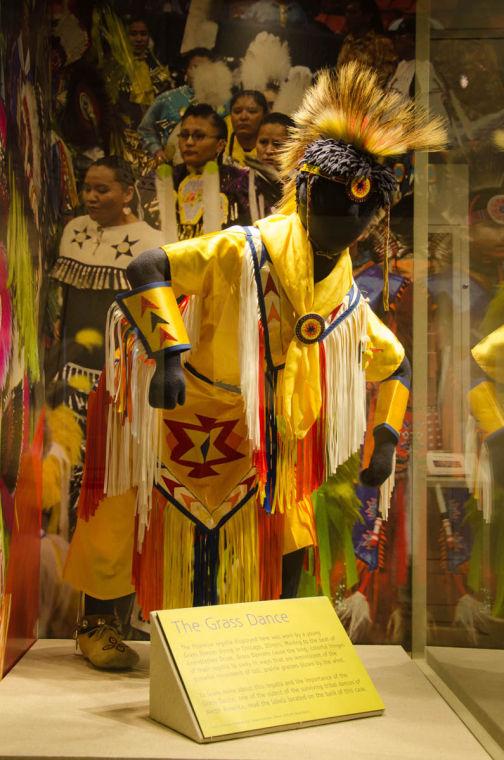Winter Tales to bring Native American narratives to life
February 20, 2014
When Native American storyteller Tchin asks his audience what happened to Native Americans, he often gets this response: living on reservations or not living at all.
In other words, “dead.”
“The main thing is to let people know we’re still here,” said Tchin, award-winning Blackfeet and Narragansett storyteller. “We’re still living in our means and culture in what is allowed to be.”
Tchin said he desires to bring this message to the University as the featured storyteller of Spurlock Museum’s annual Winter Tales on Saturday. The program features American Indian storytelling and is one of the Museum’s most popular events, according to the Museum’s website. Tchin will be a newly featured storyteller and the Museum’s first featured Blackfeet/Narragansett artist.
The Winter Tales began in 2003 after Tandy Lacy, Spurlock Museum’s director of education, visited the Newberry Library in Chicago and discovered that they brought storytellers for their American Indian storytelling event each February. Valuing the power of storytelling, Spurlock sought the opportunity to collaborate with Newberry Library. For the first two years, they hosted the same storytellers each year. For its third year, Spurlock Museum started featuring its own for the Winter Tales.
Get The Daily Illini in your inbox!
“We see the event as an extension of the education the Museum does through our Laubin Gallery of American Indian Cultures,” said Kim Sheahan, assistant director of education. “We see stories as an effective, engaging way of connecting people with artifacts and the cultures they come from.”
Spurlock Museum decided to invite Tchin after Dovie Thomason, a regular performer for the museum, recommended him. Initially, Tchin made a living producing artwork and goods after he graduated from the Rhode Island School of Design. It was not until the American Museum of Natural History in New York asked him to do a program on the Native American flute that his storytelling career began. Since then, he has spoken at various workshops and lectures about the Native American culture, which were “amazing” to him at that time, he said.
“I didn’t have to make anything. I told them what I knew, I explained it and demonstrated it, and I got paid,” Tchin said.
Growing up in Norfolk, Va., storytelling was an everyday aspect of life. And so it did not seem exclusive to “Native American culture,” he said.
“Your whole life you’re hearing stories (as a Native American) everywhere you are and every time you’re around other native people,” he said. “Especially at family times and you kind of get bored actually because you hear it over and over again. I want to do that where you don’t bore people. It’s exciting, it’s new and it’s still traditional.”
Tchin’s aim is to tell Native American stories in a way that is acceptable for the contemporary times while still holding onto its traditional origins. The challenge is to rework stories that usually go on for hours into a 10 to 15 minute presentation that connects the audience to the Native American culture, he said.
“It’s the little differences and little nuances. I’d like them to have questions and to learn something about Native culture that they didn’t know before,” Tchin said.
Jamie Singson, director of the Native American House, also sees this event as a valuable opportunity for those who identify themselves as Native Americans. There are only 35 students who identify themselves as American Indian or Native Alaskan in the enrollment records, according to Singson.
“This can be a really lonely place for those coming a long away and being separated from their traditional cultures,” he said. “Even if they may not be of the same tribal affiliation of the storyteller, it’s still important for them to have programming and events that they can relate to and make them not feel so lonely in a place that can be hard to be when you’re so far way from the indigenous people you affiliate with.”
Although only a small number may be able to personally identify with the culture, Singson, the Spurlock Museum and Tchin hope the Winter Tales will help viewers feel more connected as a community through the overall value of storytelling and awareness of the Native American culture.
“People can see something that is specific to an aspect of indigenous understanding that help you learn why stories are resilient, why they last through time and how oral traditions sometimes is a way to transmit information and knowledge in ways that we can be in jeopardy of losing through the digital age,” Singson said.
Tchin expressed similar sentiments, hoping others will become aware of the strength and perseverance of “hidden people.”
“We are just human beings like everyone else. We put our pants on one leg at a time,” Tchin said. “I hope people will leave knowing that we are still a strong people. We’re still here, we’re still practicing our culture, and we’re still trying to survive.”
Stephanie can be reached at [email protected].







